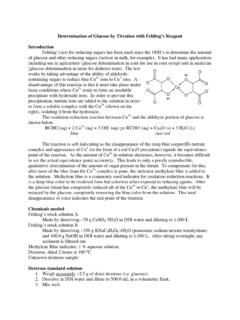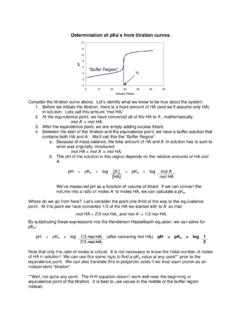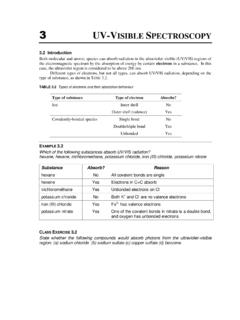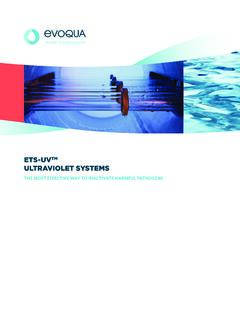Transcription of Spectroscopy in the UV and Visible: Instrumentation
1 1. Spectroscopy in the uv and visible : Instrumentation Typical UV-VIS instrument - Sample Source Detector Readout Disperser (Blank). Monitor the relative response of the sample signal to the blank P S. Transmittance T . P0 B. 2. Spectroscopy in the uv and visible : Instrumentation Components may not (at typically are not) useful for all wavelength ranges. Composition, construction limit components to finite useful wavelength ranges 1. 3. UV-Vis Sources Typically continuum sources UV Range: Hydrogen and Deuterium arc lamps Electrical excitation at low pressure (< torr) , low voltage (~40V DC).
2 Forms molecular excited state that undergoes dissociation and photoemission D2 + Ee D2* D' + D + photon Energy of photon depends on energies of D' and D . Provides continuum from ~160-380 nm 4. UV-Vis Sources visible Range: Tungsten Filament Lamps Resistively heated wire - blackbody radiation Emits from ~350-3000 nm (Fig 6-18). ~15% of radiation falls in the visible (Also Xe arc lamps - 200-1000 nm). 2. 5. UV-Vis Sources Emmison Spanning UV-VIS: Xe arc lamps High pressure Xenon gas (several atm). Emit from ~200-1000 nm (Xe line spectra in IR).
3 High voltage initiation, low voltage to maintain plasma Generate significant heat, need external cooling Hamamatsu 6. Line Sources in the UV and Vis Hollow Cathode Lamp Cathode is coated with atom of interest Tube is filled with Ar or Ne High voltage ionizes gas, charged ions are accelerated toward electrodes Produces sputtering of atoms (ground and excited). Excited atoms emit light at atomic lines Design of HCL results in redepostion of metal atoms onto electrodes - recycling Need to avoid excessively high potentials Line broadening (Doppler).
4 Self-absorption Need separate lamp for each element 3. 7. Wavelength Dispersion and Selection Why disperse the beam at all? Why disperse prior to sample? Decomposition Fluorescence See for a great online optics reference. 8. Wavelength Dispersion and Selection Most instruments use a monochromator to separate light form the source into discrete wavelength segments Components: Entrance slit Collimating/focusing device - mirror or lens, nonideal Dispersing device -filter, grating or prism Collimating/focusing device - mirror or lens Exit slit 4. 9.
5 Wavelength Dispersion and Selection Why slits? Device disperses wavelengths in space. Quantified by: Linear Dispersion, D = dy/d and Reciprocal Linear Dispersion, D-1 = 1/D. dy vs. d . By scanning the dispersed beam across a slit, a small fraction of wavelengths are allowed to pass to the sample. exit slit 10. Wavelength Dispersion and Selection How much of the beam is allowed to fit ? Ideally, exit and entrance slits are the same size Dispersing element produces slit-sized images of portions of the beam These slit-sized images are passed across the exit slit.
6 What is the response? Bandwidth = wD-1. Size of spectral slice Impact on spectral detail 5. 11. Optical Elements and Wavelength Dispersion Optical components are not ideal Lenses: Chromatic aberration because refractive index changes with wavelength focal length changes with wavelength Mirrors: Reflective losses. Lenses and inefficiencies in mirrors contribute to ~4% loss per element. Dispersive Elements: Filters Construction determines what fixed range of wavelengths will be allowed to pass. Interference Filters: sandwich containing reflective material and dielectric layer.
7 Only wavelengths that result in in-phase reflections: Depends on thickness and dielectric Absorption Filters: colored plates Light that is not absorbed by the filter is transmitted Often used in combination 12. Wavelength Dispersion: Gratings Reflection Gratings: Optically flat reflective surface with series of parallel groves of equal spacing. (60- 6000 grooves/mm). Ruled vs. Holographic i A B. r . d . Consider a monochromatic wavefront: Points A and B have same wavelength, frequency, velocity . Initially wavefront contains coincident light: Constructive interference In order for constructive interference to result after grating, A and B must travel a fixed number of wavelengths (n ).
8 Otherwise destructive interference Can solve geometrically: Grating Equation n = d(sin i + sin r). 6. 13. Wavelength Dispersion: Gratings See an overlap of orders at a given i and r Example: 1500 line/mm grating, i = , r = Characteristics Angular Dispersion: wavelength dependence of reflection Linear Dispersion: spread in wavelength along focal plane Resolving Power: ability to separate wavelengths 14. Wavelength Dispersion: Prisms Based on the fact that refractive index is wavelength dependent When light crosses the interface between materials of different , it is bent.
9 1 2. 1 2. Snell's Law: 1sin 1 = 2sin 2. For prisms, there are two interfaces to consider. Angles of refraction depend on refractive index and construction of prism Since each sees a different , varying angles result 7. 15. Monochromator Output What happens as a band of wavelengths moves across slit? I or P.. Bandpass, Bandwidth, Effective Bandwidth 16. Sample Considerations Several possible fates for photon Reflection Scattering Absorption Choose cell and sample composition carefully. Match . 8. 17. Detectors for UV-VIS. Photon Transducers: Covert photon energy to electrical signal (current, voltage, etc.)
10 Detectors based on photoelectric effect: Phototubes, Photomultiplier tubes Phototube: Incident photon causes release of an electron Photocurrent Plight Not best for low-light scenarios 18. Detectors for UV-VIS. Photomultiplier: Ejected photoelectron strikes dynode, secondary e- released Voltage accelerates e- to next dynode and so on big voltage divider Result is large charge packet hitting anode High Gain 9. 19. Detectors for UV-VIS. Semiconductor-based detectors Photodiodes, Photodiode arrays, CCD, CID. Photodiodes and Photodiode Arrays: Reverse biased junction Photons produce e-- hole pairs current Current Plight less sensitive than PMTs Photodiode Arrays: PDA.









